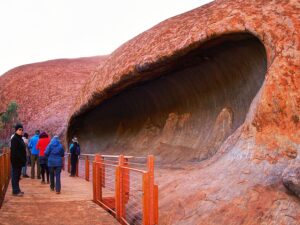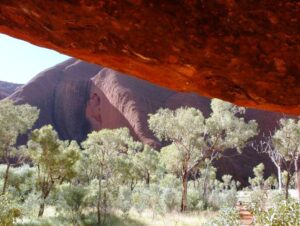» posted on Wednesday, July 27th, 2022 by Linda Lou Burton
A Little Culture
Originally Published July 27, 2020 by Linda Lou Burton posting about Uluru, Australia from Little Rock, Arkansas – I established yesterday that it is a major faux pas to climb Uluru. But climbing has been banned only since October 2019, 146 years after William Gosse spotted it and dubbed it Ayers Rock. And 55 years after a chain was planted up its side to help the white ants, as tourists were sometimes referred to by natives, claim victory at the top. The controversy over the use, value, and meaning of the giant monolith is not unlike the controversy in the United States regarding Mount Rushmore. “Meaning” comes from cultural perceptions.
 Looking out my window at Uluru, glowing in the morning sun, I see a rock, a really gorgeous piece of nature’s handiwork, a tick off my Bucket List of Natural Wonders of the World. Because I am a respectful person in general, I will honor all restrictions and requests during my visit, and do no harm. I didn’t steal a pebble in Antarctica, or take a sneak photo of Guernica in Madrid.
Looking out my window at Uluru, glowing in the morning sun, I see a rock, a really gorgeous piece of nature’s handiwork, a tick off my Bucket List of Natural Wonders of the World. Because I am a respectful person in general, I will honor all restrictions and requests during my visit, and do no harm. I didn’t steal a pebble in Antarctica, or take a sneak photo of Guernica in Madrid.
But what does Uluru mean to a culture different from mine, in this case, the Pitjantjatjara Aborigines; specifically the local Anangu? I started with a Park Fact Sheet, and an explanation of Tjukurpa (pronounced ‘chook-orr-pa’), the foundation of Anangu culture. I learned that, like religions elsewhere in the world, Tjukurpa provides answers to many important questions.
- Tjukurpa is the religious philosophy that links Anangu to the environment and our ancestors. Tjukurpa is the traditional law that tells us how to care for one another and the land that supports us. It tells of the relationships between people, plants, animals and the physical features of the land.
- Tjukurpa stories tell about the beginning of time when ancestral beings first created the world. They tell us where important places are, how to travel from one place to another, and where and when we can find water and food. They contain important lessons about the land and how to survive in the desert as well as rules for appropriate behaviour.
- Tjukurpa is not written down. It is memorised and passed on to the right people like an inheritance. This law was given to us by our grandfathers and grandmothers, our fathers and mothers, to hold onto in our heads and in our hearts.
The Tjukurpa fact sheet https://parksaustralia.gov.au/uluru/discover/culture/tjukurpa/
 Uluru holds great spiritual significance as a place where many creation stories converge. It is a meeting place with many pathways and tracks leading to and from it. Each path tells an important story that teaches a vital lesson. Walks follow the tracks of the ancestral beings. The rock’s shapes and textures hold knowledge and stories that have been passed down through generations and are still relevant today.
Uluru holds great spiritual significance as a place where many creation stories converge. It is a meeting place with many pathways and tracks leading to and from it. Each path tells an important story that teaches a vital lesson. Walks follow the tracks of the ancestral beings. The rock’s shapes and textures hold knowledge and stories that have been passed down through generations and are still relevant today.
Mala Walk The Mala people are the Anangu’s ancestors, and their story is one of the most important of Tjukurpa. This walk includes the caves where they camped when they first arrived at Uluru; the kitchen cave where they prepared their meals. Rock art to see along this walk.
Mutitjulu Waterhole Mutitjulu Waterhole is a place to listen quietly to the sounds of the beginning of time. The presence of water means this area is particularly lush and shady. Wallabies wander the tall grasses and river red gum trees. Bush foods abound, tjantu (bush tomatoes), ili (figs) and arnguli (bush plums).
 Kuniya Walk The Kuniya walk is the site of one of Uluru’s most dramatic creation stories – the deadly battle between Kuniya (the woma python woman) and Liru (the poisonous brown snake man). Here, understand how creation stories are played out on the surface of Uluru today. Kuniya and her spirit are here, and the caves she protects are still used by Anangu.
Kuniya Walk The Kuniya walk is the site of one of Uluru’s most dramatic creation stories – the deadly battle between Kuniya (the woma python woman) and Liru (the poisonous brown snake man). Here, understand how creation stories are played out on the surface of Uluru today. Kuniya and her spirit are here, and the caves she protects are still used by Anangu.
Liru Walk The Liru walk (named after the poisonous brown snake) winds through a mulga forest and connects the Cultural Centre with the base of Uluru; a fantastic place to soak up the solitude, listen to the wind in the trees and contemplate the sheer magnitude of Uluru.
Lungkata Walk Tjukurpa teaches not to steal from others through the story of Lungkata (the cheeky blue-tongue lizard man). Panpalala birds sing, ancestral birds that play a part in the Lungkata creation story. With binoculars or a long lens see hundreds of tiny birds nesting high up in the caves.
Northeast Face Walk The northeast face of Uluru is dotted with sacred sites. According to Anangu culture, the rock formations here hold chapters of creation stories that should only be learned in person. It is inappropriate for any images of these sites to be viewed elsewhere. For these reasons, Anangu request that you enjoy the scenery of the northeast face but do not take any photographs. By following this request, you are ensuring the continuation of Anangu cultural beliefs and the protection of their spirituality.
Put away the camera, be in the moment and experience the calm, peaceful environment that surrounds you. When you return from the park, tell your friends that they have to visit for themselves, because there are some parts of Uluru that you can only see in person.
And so I deliver that message to you today.
Tomorrow I head for Canberra, the national capital. And I’ll tell you more about AIATSIS, the Australian Institute of Aboriginal and Torres Strait Islander Studies, a government agency focusing on the history and culture of Aboriginal Australia.
